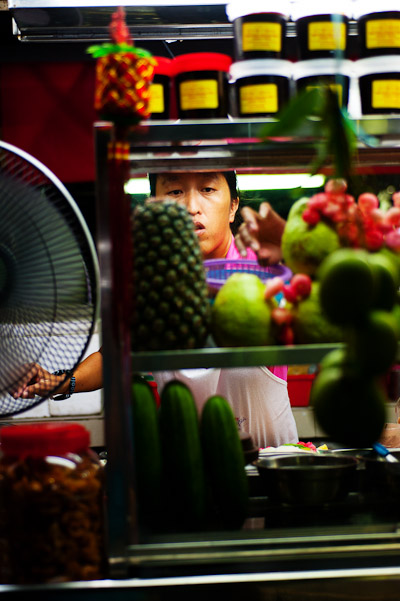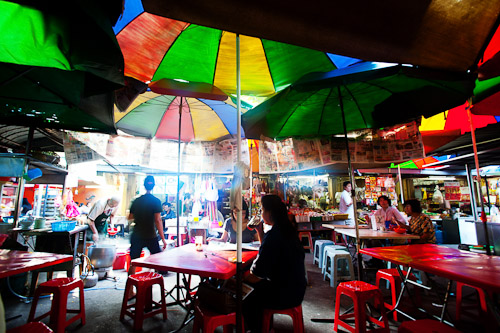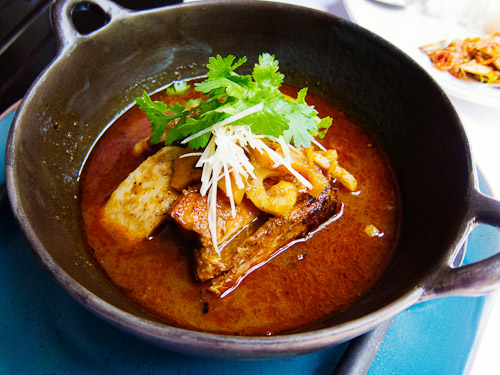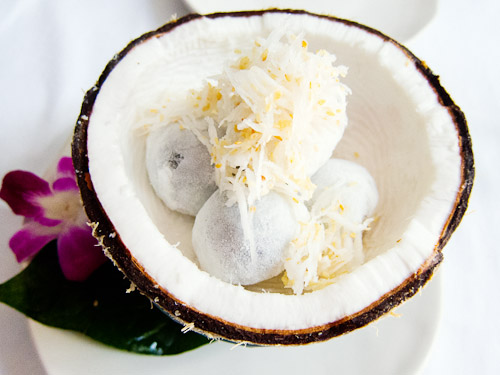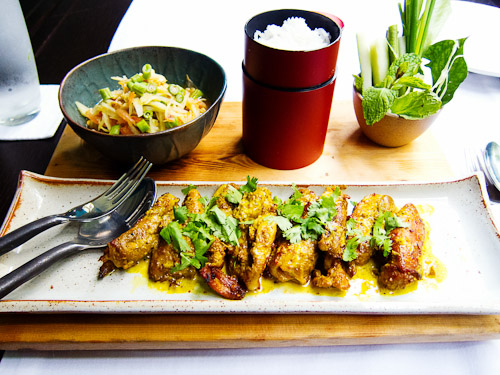Ah Chye
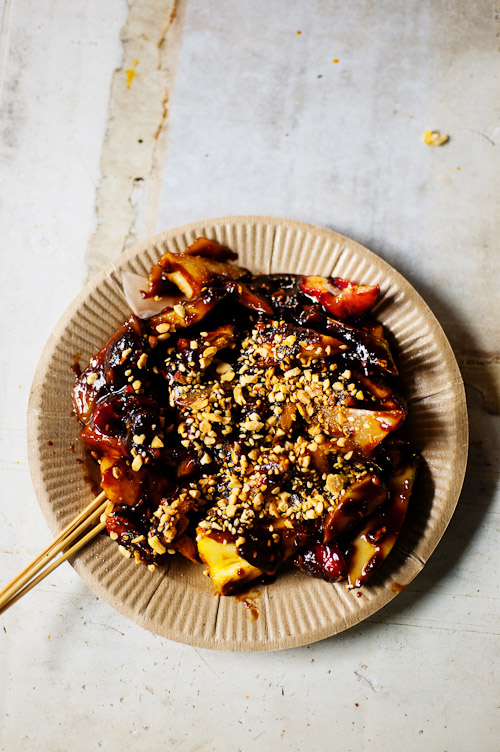 The dish I was probably looking the most forward to eating in Malaysia is rojak, a type of fruit salad with a thick, intense dressing that practically screams Southeast Asia. I didn't come across any in KL, but from previous trips to Penang, I knew that I needed to head for Georgetown's busy Gurney Driver hawker market:
The dish I was probably looking the most forward to eating in Malaysia is rojak, a type of fruit salad with a thick, intense dressing that practically screams Southeast Asia. I didn't come across any in KL, but from previous trips to Penang, I knew that I needed to head for Georgetown's busy Gurney Driver hawker market:
There, Ah Chye, a lauded and busy stall, does the Penang version of the dish, which I've been told is particular about the inclusion of rose apples (the tiny pink kind known in Thai as mamiaw) and squid. Ah Chye's rojak also has crunchy guava, jicama and cucumber, bits of crispy deep-fried dough, sweet mangoes and tart chunks of pineapple. These disparate ingredients come together with the help of a virtually mud-thick sweet/fishy/sour/spicy dressing made from shrimp paste and sugar (Ah Chye's dressing is so popular, it's available in take-away tubs). And as if there wasn't already enough going on, the dish is garnished with ground peanuts and sesame.
Excellent, but I want more. Penangites/Georgetownians: Where do you like to get your rojak on?
Ah Chye Gurney Drive Hakwer Stalls, Georgetown, Penang, Malaysia Dinner
View Thai Eats in a larger map
Penang
 I'm now in Penang and frankly, am feeling overwhelmed. I've only been here two and a half days and already feel as if I've lost track of all the delicious things I've consumed. I'll do my best to keep up and blog about the amazing food here, but suspect it's going to be tough.
I'm now in Penang and frankly, am feeling overwhelmed. I've only been here two and a half days and already feel as if I've lost track of all the delicious things I've consumed. I'll do my best to keep up and blog about the amazing food here, but suspect it's going to be tough.
In a good way, of course.
More to come soon...
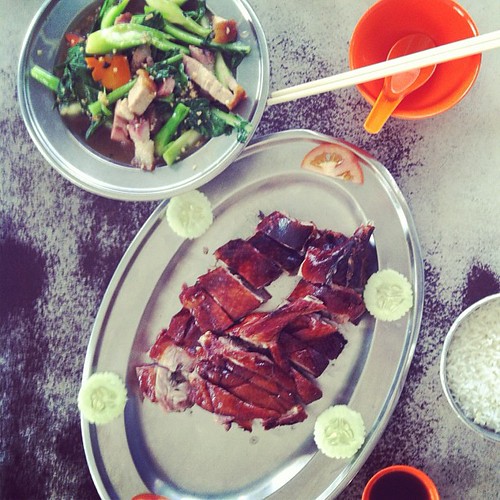 My lunch was better than yours: Sek Yuen, Kuala Lumpur
My lunch was better than yours: Sek Yuen, Kuala Lumpur
Back in the MY
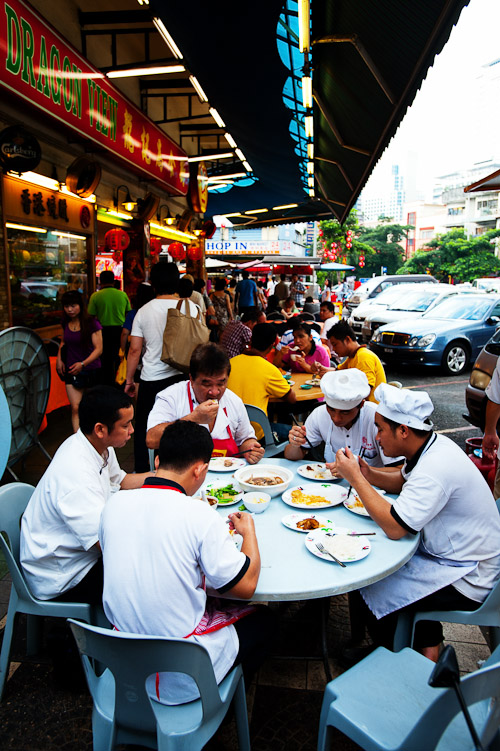 This may come as a surprise to people who've been reading this blog for a while, but I'd wager that Malaysia is the best eating destination in Southeast Asia. I love Thai food, but having lived in Thailand a long time now, I've always been secretly jealous of Malaysia's variety: regional Chinese, Indian, and of course, Malaysian cuisines are available just about everywhere there. Food in Malaysia generally isn't super sweet -- a flavour the Thais love, but one I'm not so hot about. And Malaysia seems to have a disproportionate amount of the type of stuck-in-time old-school restaurants that one really has to work hard to find in Thailand.
This may come as a surprise to people who've been reading this blog for a while, but I'd wager that Malaysia is the best eating destination in Southeast Asia. I love Thai food, but having lived in Thailand a long time now, I've always been secretly jealous of Malaysia's variety: regional Chinese, Indian, and of course, Malaysian cuisines are available just about everywhere there. Food in Malaysia generally isn't super sweet -- a flavour the Thais love, but one I'm not so hot about. And Malaysia seems to have a disproportionate amount of the type of stuck-in-time old-school restaurants that one really has to work hard to find in Thailand.
So I'm very happy to be back.
My main reason for being in Malaysia is to begin work on Lonely Planet's Malaysia, Singapore & Brunei, but I spent my first several days in country in Kuala Lumpur, doing a photo shoot. The running around didn't leave me time to do to much exploration, but I was still able to eat well, and hit now-familiar EatingAsia faves Yut Kee, Bakti Woodlands and Sek Yuen, not to mention LP-recommended places including Jalan Alor and Imbi Market:
But my most memorable meal in KL was probably at Vishalatchi Food & Catering, a southern Indian restaurant suggested by Jarrett:
Unlike most southern Indian places I've encountered in KL, this place is not vegetarian, and in fact sold one of the best versions of mutton biryani I've encountered in a long time:
Served with short-grain rice that's fragrant but not over-seasoned with dried spices, a hard-boiled egg and fall-apart tender mutton (not to mention the tasty all-you-can-eat vegetable-based sides), on a banana leaf on a long communal table, in a hall-like room with the music and noise spilling over from a ceremony at an adjacent Hindu temple, it was much an experience as it was a meal.
My next destination is Penang, where I have plans to meet up with some locally-based bloggers and food experts, and most likely, experience even more excellent Malaysian food.
Visalatchi Food & Catering 18 Jalan Scott, Kuala Lumpur 012 311 2837
View Thai Eats in a larger map
Dee Mee Phochana/ดีมีโภชนา
 It's my favourite kind of culinary discovery: an old-school restaurant that's new to me.
It's my favourite kind of culinary discovery: an old-school restaurant that's new to me.
Guided by Ideal Map's Good Eats: Rattanakosin, a food-based map to Bangkok, I was recently pointed in the direction of Dee Mee Phochana, decades-old restaurant located in an even older neighbourhood.
Dee Mee is your classic Bangkok-style khao tom restaurant, serving a variety of prepared Thai-Chinese-style dishes. Just point at whatever looks good, and a few small plates will be brought to your table, to be accompanied by regular rice or a watery bowl of rice soup.
I went for a combo of khaa muu, braised pork leg, and tao huu phalo, tofu braised in Chinese spices, as well as a unique dish of fish served with pickled vegetables:
The phalo was a pleasant surprise, and turned out to be one of the better versions of the dish I've encountered in a while. Many versions of this dish can be cloyingly sweet, but the sweetness here was subtle, and was accentuated by spices such as cinnamon and clove, not more sugar. The pork leg was tender, with similar flavours, and both were accompanied by a tart, spicy, garlicky dipping sauce. The fish dish was one I hadn't encountered previously, and combined tasty braised freshwater fish, crunchy chunks of pickled mustard green and a 'red broth' (nam daeng) that brought it all together.
Dee Mee Phochana Th Ban Mor, Bangkok 11am-10pm Mon-Sat 02 226 4158
View Thai Eats in a larger map
Instagram: Culinary booty taken from Mae Hong Son
Issaya Siamese Club
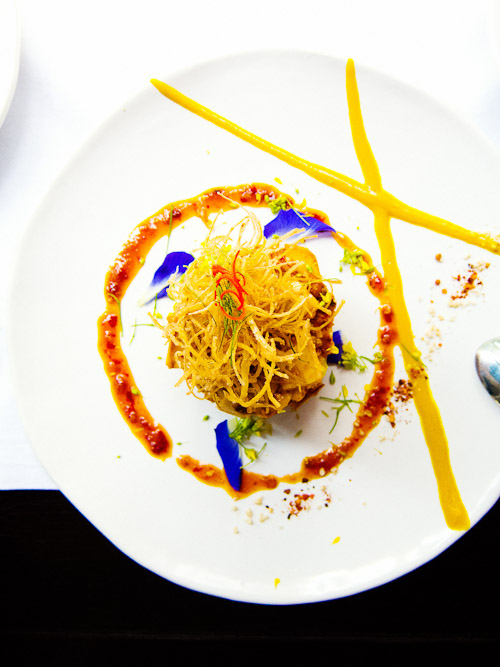 Issaya Siamese club is the first domestic outlet serving Thai food of Bangkok-born chef, Ian Kittichai. As the story goes, Chef Ian started cooking as a child, selling food from a cart along the streets of Bangkok, before eventually going on to helm the Four Seasons Bangkok, and later, Kittichai, in New York City.
Issaya Siamese club is the first domestic outlet serving Thai food of Bangkok-born chef, Ian Kittichai. As the story goes, Chef Ian started cooking as a child, selling food from a cart along the streets of Bangkok, before eventually going on to helm the Four Seasons Bangkok, and later, Kittichai, in New York City.
His most recent restaurant (Issaya) is housed in a charming 1920s-era villa that has been playfully designed by a Danish interior designer. There's a small organic garden out back, lots of lounge-like cozy corners (the Siamese Club part) and in the evenings, lawn seating on comfy-looking cloth chairs.
The restaurant's relatively short menu, referred to as the chef's Childhood Menu, claims to be a collection of 'Favourite dishes from Chef Ian's Childhood'. A review in local listings mag BK mentioned that one of these dishes is Gaeng hung lay, the restaurant's take on kaeng hang lay, a northern-style curry of pork belly. This might very well be the one Thai dish I've cooked and consumed more than any other, and I was curious to see how the restaurant did it:
Like the dishes that followed it, there seemed to be a distinct emphasis on presentation, and by Thai standards at least, serves were huge. The hang lay had the requisite pork belly and hints of dried spice, but these were nearly lost in the curry's overwhelming richness and oiliness. Kaeng hang lay is indeed a rich and oily dish, but usually this is countered by the addition of a few tablespoons of tart tamarind extract, as well as acidic slivers of ginger and small cloves of garlic. Instead, Issaya's version was served with a large chunk of taro and a couple slices of lotus root. These additions are novel (although in Mae Hong Son they do a dish called aloo hang lay, hang lay served with potatoes), yet did little to bring balance to the dish, and instead seemed to make it even heavier.
The waiter recommended the Chili glazed baby back ribs:
which arrived on a smoking Thai-style grill. They were smokey, crispy and tender, but despite Asian-inspired ingredients in the glaze, the dish had more in common with American-style barbecue than anything with origins in Southeast Asia. It was a satisfying -- if somewhat out of place -- dish, but was this really something from the chef's childhood in Bangkok?
In an effort to counter the meatiness, we ordered banana blossom salad (pictured at the top of this post). I didn't even recognise the dish when it arrived, which wouldn't be so bad if I hadn't also failed to recognise its flavours. The salad lacked that crucial intersection of astringency, sweetness, spiciness and coconut milk creaminess, and like the other dishes, seemed to be drowning in an overbearing sauce.
For dessert, we chose the restaurant's take on khanom kho, a Thai sweet I've encountered previously in the southern Thai provinces of Songkhla and Pattani. The traditional version of the dish takes the form of tiny and almost impossibly light pillows of dough enveloping a crunchy core of sugarcane. Issaya's version took the form of large and rather tough Japanese-style moji encasing sesame ice cream:
Again, the presentation was unique, and on the surface at least, the dish sort of resembled khanom kho, but given the wholesale lack of the original dish's defining elements (delicacy, lightness, softness), why not just call it something else?
On a subsequent visit, I tried the restaurant's street food set, which combined grilled chicken, papaya salad and sticky rice:
The grilled chicken took the form of skinless, boneless breast and/or thighs grilled and served in a marinade that combined lots of coconut milk and turmeric, but none of the spicy peppery, savoury flavours of coriander root, white pepper garlic or even salt -- ingredients one would usually encounter in this dish. It seemed more like a clumsy stab at Malaysian food than any Thai street food I'd ever encountered. The papaya salad was unexceptional, and because the restaurant was out of sticky rice, I was given regular rice.
Both experiences were underwhelming, but perhaps the fault was in my ordering? On my first visit, and following the waiter's suggestion, we ended up with three rather meaty and saucy dishes -- hardly a balanced Thai meal. But after a second visit, I suspect that my ultimate mistake was in expecting Thai food. Given Chef Ian's experience and success in the US, the emphasis on presentation, the huge serves, and the general meatiness and sauciness, I couldn't help but wonder, Could Issaya Siamese Club be an example of a chef bringing Thai-American restaurant food to Bangkok?
Issaya Siamese Club 4 Th Sri Aksorn, Bangkok 02 672 9040 11:30am-3pm, 6pm-midnight
View Thai Eats in a larger map
Instagram: Bus stop, Mae Sariang
Instagram: Bus stop dinner, boar fried w curry paste, Mae Sarieng
Khang pong/ข่างปอง
 Khang pong, crispy fritters made from shredded and battered green papaya, or sometimes shallots, are one of the more ubiquitous snacks in Mae Hong Son. The dish is sold at several stalls in the town's morning market as well as from roadside stalls in the countryside. But my favourite version is sold by one particular vendor at the city's walking street market:
Khang pong, crispy fritters made from shredded and battered green papaya, or sometimes shallots, are one of the more ubiquitous snacks in Mae Hong Son. The dish is sold at several stalls in the town's morning market as well as from roadside stalls in the countryside. But my favourite version is sold by one particular vendor at the city's walking street market:
I’ve been buying khang pong from this woman for years, and on my most recent visit, mentioned to her that my friend, a restaurateur in the US, was so taken with the dish that he decided to make a version of it at his restaurant (for a description of this, go here). ‘Tell him he can come by and ask for the recipe,’ she said without hesitation. ‘I won’t charge anything!’
She went on to describe that khang is Shan/Thai Yai for pan, and pong means golden:
While most khang pong are served as a crispy side to noodle dishes, hers are excellent on their own as a snack. Also unlike the version sold around town, hers are somewhat spicy, and come liberally seasoned with citrusy bits of lemongrass, turmeric and dried chili. Another difference is that unlike most vendors, who deep-fry khang pong, she pan fries hers, making them dense and somewhat heavy -- almost like a savoury cookie.
If you're interested in making the dish, the below is the translation of a recipe from สูตรอาหารและขนมไต, Tai Recipes and Sweets, a cookbook assembled by a Mae Hong Son community group. I've made a few dishes from the book, including this one, and the proportions aren't always exact, so if you're going to have a go, be sure to employ a bit of cooking experience and intuition.
Khang Pong/ข่างปอง (Thai Yai-Style Battered and Deep-Fried Papaya)
Green papaya, 1kg Lemongrass, 5 stalks Shrimp paste, 1 Tbsp Shallots, 5 Garlic, 3 heads Salt, 1 Tbsp Turmeric, 1 tsp MSG, 1 tsp Rice flour, 1 bag [an average bag contains 450g] Sticky rice flour, 1/4 bag
Oil for frying
Peel papaya, rinse with water. Cut into bite-sized strips.
In a mortar and pestle, combine lemongrass, shrimp paste, shallots, garlic, salt and MSG. Grind until you have a fine paste.
Combine papaya, spice mixture, flours and add water until you have a thick batter.
Shaping mixture into small rounds, fry until crispy and golden.
Or, if you live in Portland, Oregon, head to Whiskey Soda Lounge, where they might still be on the menu.
Khang Pong Mae Hong Son’s night market 4-8pm
View Thai Eats in a larger map
Instagram: สุดยอดแห่งความส้มตำผลไม้, แม่ฮ่องสอน
Instagram: Last dinner in Mae Hong Son
Chay Thung/ชายทุ่ง
 Chay Thung, somewhat unceremoniously, translates as 'At the Edge of the Fields', which given the views provided by Mae Hong Song's rice fields in late January:
Chay Thung, somewhat unceremoniously, translates as 'At the Edge of the Fields', which given the views provided by Mae Hong Song's rice fields in late January:
is almost self-deprecating in its understatement.
The restaurant serves a good spread of Isan/northeastern Thai-style dishes, but the house specialty is kai op faang (ไก่อบฟาง), literally 'chicken baked over hay'. Ovens are unknown in rural Thailand, and instead the chicken is 'baked' in a clever contraption fashioned from two items one would normally throw away.
To make the dish, a whole chicken, which has been seasoned with fish sauce, MSG and garlic, is inserted, upright, on a bottle filled with water. The 'oven', actually an empty metal oil can, is dropped over the bird, and the whole lot is covered with a huge mound of hay (actually dried rice stalks).
The hay is lit on fire:
and initially, there's a huge flame:
which burns away within a couple minutes, leaving a pile of very hot ashes. After about 20 minutes, virtually all that's left is a hot metal box encasing a smokey and tender 'baked' chicken:
While this is going on, the feet, head, neck and gizzards are made into a deliciously rich broth, which is seasoned with lemongrass, black pepper and turmeric.
Eaten with sticky rice and the restaurant's excellent som tam (green papaya salad), the meal (pictured at the top of this post) is quite possibly the most satisfying chicken dish I've encountered in Thailand over the last few years.
Part of the dish's success can be traced back to its unique cooking method, but in my opinion, this is a dish in which the ingredients also play a crucial role: the chicken used at Chay Thung is kai baan, scrawny free-range birds with rich flesh that tends to cook up somewhere between slightly moist and almost dry, and which inevitably have lots of fatty skin. A breast-heavy Western-style chicken would most likely dry out, and would not have that satisfying intersection of almost equal parts verging-on-dry-but-still-tender meat and crispy, fatty skin.
On subsequent visit, I had Chay Thung's excellent laap pet (duck 'salad'):
rich, spicy and tart, and served with delicious raw vegetables and herbs grown in the fields that surround the restaurant.
A must-visit restaurant, if you're in the area.
Chay Thung Outside Ban Pha Bong, Rte 108, Mae Hong Son 053 686 123
View Thai Eats in a larger map
Back in the MHS
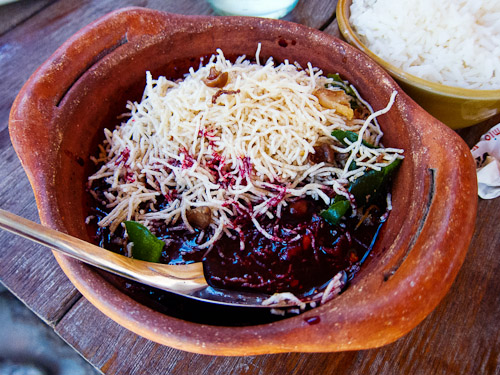 I couldn't swing an entire month this time around, but I've managed to squeeze in about nine days up in my favourite place in Thailand, the northwestern province of Mae Hong Son.
I couldn't swing an entire month this time around, but I've managed to squeeze in about nine days up in my favourite place in Thailand, the northwestern province of Mae Hong Son.
I've spent a lot of time up here, and I've been visiting the area since 1998, so I'm pretty familiar with the city's restaurants and stalls. I love the food in Mae Hong Son, but it's a small town, and the options are limited.
Perhaps in an conscious effort to avoid ordering the same old dishes, on a recent visit to Baan Phleng, we ordered luu, a dish of raw blood that I've previously described here. It's an intimidating dish -- perhaps the most so in all of Thailand -- and if you smile while you're eating it, you look like a murderous carnivore. But luu is actually relatively subtle in terms of flavour, and boasts a touch of chili heat coupled with the unique dried spice notes that characterise northern-stye laap. And as far as I'm aware, all of the people who sampled the luu pictured above are still alive and healthy.
Baan Phleng is probably Mae Hong Son's best all-around restaurant, and serves a wide spread of mostly blood-free Thai Yai/Shan-style and northern Thai style dishes.
A few slightly less-intimidating Mae Hong Son dishes to follow soon...
Baan Phleng 108 Th Khunlum Praphat, Mae Hong Son 053 612 522 8am-8pm
View Thai Eats in a larger map













